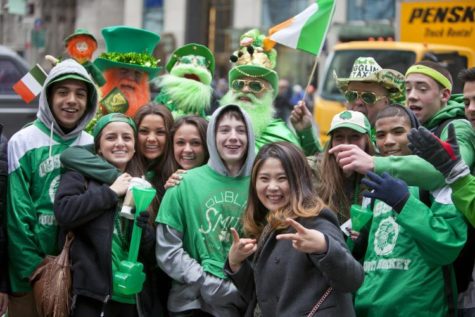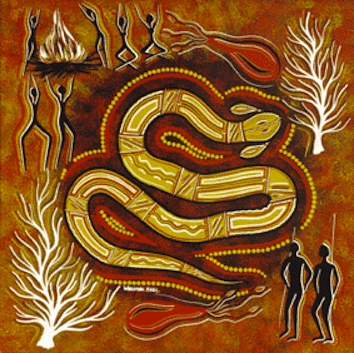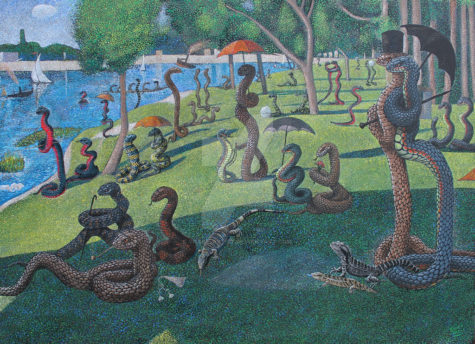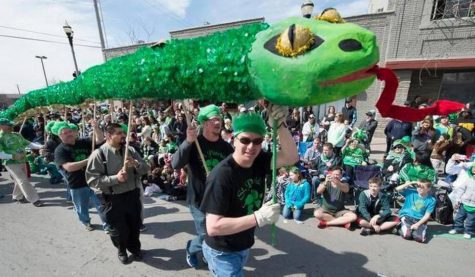St Patrick’s Day
March 17 commemorates Saint Patrick, the patron saint and national apostle of Ireland, and the arrival of Christianity in Ireland. In addition, this day also celebrates the heritage and culture of the Irish in general.
Celebrations generally involve public parades and festivals, céilithe (Irish traditional music sessions), and the wearing of green attire or shamrocks. There are also formal gatherings such as banquets and dances, although these were more common in the past. St Patrick’s Day parades began in North America in the 18th century but did not spread to Ireland until the 20th century.
The participants generally include marching bands, the military, fire brigades, cultural organisations, charitable organisations, voluntary associations, youth groups, fraternities, and so on. However, over time, many of the parades have become more akin to a carnival. More effort is made to use the Irish language; especially in Ireland, where the week of St Patrick’s Day is “Irish language week”. Recently, famous landmarks have been lit up in green on St Patrick’s Day.
Christians also attend church services and the Lenten restrictions on eating and drinking alcohol are lifted for the day. Perhaps because of this, drinking alcohol – particularly Irish whiskey, beer or cider – has become an integral part of the celebrations.
The St Patrick’s Day custom of ‘drowning the shamrock‘ or ‘wetting the shamrock‘ was historically popular, especially in Ireland. At the end of the celebrations, shamrock is put into the bottom of a cup, which is then filled with whiskey, beer or cider. It is then drank as a toast; to St Patrick, to Ireland, or to those present. The shamrock would either be swallowed with the drink, or be taken out and tossed over the shoulder for good luck.
In every household the herb is placed upon the breakfast table of the master and the mistress, who “drown the shamrock” in generous draughts of whiskey, and then send the bottle down into the kitchen for the servants.
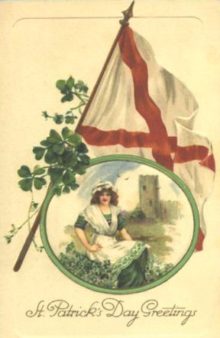 On St Patrick’s Day it is customary to wear shamrocks and/or green clothing or accessories (the “wearing of the green”). St Patrick is said to have used the shamrock, a three-leaved plant, to explain the Holy Trinity to the pagan Irish. This story first appears in writing in 1726, though it may be older.
On St Patrick’s Day it is customary to wear shamrocks and/or green clothing or accessories (the “wearing of the green”). St Patrick is said to have used the shamrock, a three-leaved plant, to explain the Holy Trinity to the pagan Irish. This story first appears in writing in 1726, though it may be older.
Long before the shamrock became associated with St. Patrick’s Day, the four-leaf clover was regarded by ancient Celts as a charm against evil spirits.
In pagan Ireland, three was a significant number and the Irish had many triple deities, a fact that may have aided St Patrick in his evangelisation efforts. Patricia Monaghan says there is no evidence that the shamrock was sacred to the pagan Irish. However, Jack Santino speculates that it may have represented the regenerative powers of nature, and was recast in a Christian context—icons of St Patrick often depict the saint “with a cross in one hand and a sprig of shamrocks in the other”. Roger Homan writes, “We can perhaps see St Patrick drawing upon the visual concept of the triskele when he uses the shamrock to explain the Trinity”.
In the early 1900’s, O. H. Benson, an Iowa school superintendent, came up with the idea of using a clover as the emblem for a newly founded agricultural club for children in his area. In 1911, the four-leaf clover was chosen as the emblem for the national club program, later named 4-H.
The color green has been associated with Ireland since at least the 1640’s, when the green harp flag was used by the Irish Catholic Confederation. Green ribbons and shamrocks have been worn on St Patrick’s Day since at least the 1680s. The Friendly Brothers of St Patrick, an Irish fraternity founded in about 1750, adopted green as its color.
However, when the Order of St. Patrick—an Anglo-Irish chivalric order—was founded in 1783 it adopted blue as its color, which led to blue being associated with St Patrick. During the 1790’s, green would become associated with Irish nationalism, due to its use by the United Irishmen. This was a republican organisation—led mostly by Protestants but with many Catholic members—who launched a rebellion in 1798 against British rule.
The phrase “wearing of the green” comes from a song of the same name, which laments United Irishmen supporters being persecuted for wearing green. Throughout the 19th and 20th centuries, the color green and its association with St Patrick’s Day grew.
The wearing of the ‘St Patrick’s Day Cross’ was also a popular custom in Ireland until the early 20th century. These were a Celtic Christian cross made of paper that was “covered with silk or ribbon of different colors, and a bunch or rosette of green silk in the center”.
The most popular of the many legends about St. Patrick is the one which credits him for having driven all the snakes and vermin out of Ireland.
Here’s an old old poem about it:
There’s not a mile in Ireland’s isle
where the dirty vermin musters;
Where’er he put his dear forefoot
he murdered them in clusters.
The toads went hop, the frogs went flop,
slap dash into the water,
And the beasts committed suicide to
save themselves from slaughter.
Nine hundred thousand vipers blue
he charmed with sweet discourses.
And dined on them at Killaloo
in soups and second courses.
When blindworms crawling on the grass
disgusted all the nation,
He gave them a rise and opened their eyes
to a sense of the situation.
The Wicklow Hills are very high, and
so’s the Hill of Howth, sir;
But there’s a hill much higher still—ay,
higher than them both, sir;
‘Twas on the top of this high hill St.
Patrick preached the sarmint
That drove the frogs into the bogs and
bothered all the varmint.
About St Patrick
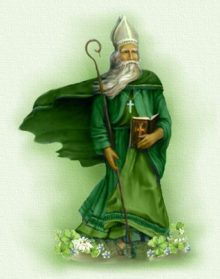 Patrick was a 5th-century Romano-British Christian missionary and bishop in Ireland. Much of what is known about Saint Patrick comes from the Declaration, which was allegedly written by Patrick himself. It is believed that he was born in Roman Britain in the fourth century, into a wealthy Romano-British family. His father was a deacon and his grandfather was a priest in the Christian church.
Patrick was a 5th-century Romano-British Christian missionary and bishop in Ireland. Much of what is known about Saint Patrick comes from the Declaration, which was allegedly written by Patrick himself. It is believed that he was born in Roman Britain in the fourth century, into a wealthy Romano-British family. His father was a deacon and his grandfather was a priest in the Christian church.
According to the Declaration, at the age of sixteen, he was kidnapped by Irish raiders and taken as a slave to Gaelic Ireland. ] It says that he spent six years there working as a shepherd and that during this time he “found God”. The Declaration says that God told Patrick to flee to the coast, where a ship would be waiting to take him home. After making his way home, Patrick went on to become a priest.
According to tradition, Patrick returned to Ireland to convert the pagan Irish to Christianity. The Declaration says that he spent many years evangelising in the northern half of Ireland and converted “thousands”. Patrick’s efforts against the druids were eventually turned into an allegory in which he drove “snakes” out of Ireland (Ireland never had any snakes).
Tradition holds that he died on 17 March and was buried at Downpatrick. Over the following centuries, many legends grew up around Patrick and he became Ireland’s foremost saint.
NOTE:
What many people don’t realize is that the serpent was actually a metaphor for the early Pagan faiths of Ireland. St. Patrick brought Christianity to the Emerald Isle, and did such a good job of it that he practically eliminated Paganism from the country. Because of this, some modern Pagans refuse to observe a day which honors the elimination of the old religion in favor of a new one. It’s not uncommon to see Pagans and Wiccans wearing some sort of snake symbol on St. Patrick’s Day, instead of those green “Kiss Me I’m Irish” badges.
Sources: Almanac.com, Wikipedia, and Encyclopaedia of Superstitions, Folklore, and the Occult Sciences
- Other names: Damballah Weddo, Da, Papa Damballa, Obatala
- Holiday: March 17 (St. Patrick’s Day)
Associated Catholic Saint Patrick (who drove the snakes out of Ireland), and sometimes also Moses, whose staff transformed into a snake to prove the power of God over that wielded by Egyptian priests, Damballah is the primordial snake Iwa of life, wealth and wisdom. He is venerated in Dahomey as well as Haitian Vodou. He may also survive in the New Orleans folk saint Blanc Dani.
He is one of the most important of all the loa, Damballa is the Sky Father and the primordial creator of all life. He rules the mind, intellect, and cosmic equilibrium. Damballa, as the serpent spirit and “The Great Master”, created the cosmos by using his 7,000 coils to form the stars and the planets in the heavens and to shape the hills and valleys on earth. By shedding the serpent skin, Damballa created all the waters on the earth.
Read more about him here: Damballah
Offerings:
For a very traditional offering, make a bed or hill of white flour on a perfectly clean, pure white plate. Nestle one whole, raw white egg into the center of the flour and serve.
Other offerings could include white candles and white foods like rice, milk, whole raw eggs (leave them plain or rub gently with rose or other mildly scented, fine quality floral water), corn syrup, white chickens, or white flowers. More lavish offerings might include luxurious white fabrics, crystal or porcelain eggs and/or snakes.
He is a stickler for cleanliness. He doesn’t like strong, pervasive odors of any kind, but especially tobacco. If you smoke, then do so far from his altar space or anywhere associated with him. He may object to cleaning products with strong odors too, as well as air fresheners with strong aromas. Rooms should smell clean and fresh. Open a window to aerate them. He does not object to light floral odors, like rose or orange blossom water, and traditionally expresses a fondness for Pompeii Lotion, a cologne product found in botanicas and spiritual supply stores.
From: Encyclopedia of Spirits
Snake Sunday is a holiday celebrated the Sunday before St. Patrick’s Day. Typically it is used as a way of dealing with a hangover from celebrating a “pseudo” St. Patrick’s Day which is commonly done by partaking of the great Irish tradition on a Saturday night when the actual holiday is during the work week.
Commonly in honor of Snake Sunday, celebrators will exclaim “SNAKE SUNDAY” typically in unison. This cheer usually follows either the question, “What day is it?” some variant thereof, or if someone says “Happy Snake Sunday!”
Example:
Ted: “Hey Lance, how you doing today?”
Lance: “Hey Ted, pretty hungover from celebrating St. Patrick’s Day last night, but otherwise it’s a great Snake Sunday!”
Ted/Lance: “SNAKE SUNDAY!!!”
Source: Urban Dictionary
Snake Saturday Parade & Festival, celebrated on the Saturday before St Patrick’s Day, has become the largest family fun Irish celebration in the Kansas City Metro area. It also generates an enormous amount of exposure and charitable donations to benefit local non-profit organizations.
Each year Snake Saturday Parade & Festival awards cash prizes to some 50 –100 local charities that participate in the festivities.
Parade Founder Mickey Finn tells the story of how Snake Saturday came to life in 1983. The concept started as a promotion for Rodeway Inn, with four floats, a Grand Marshal and co-founder, Bill Grigsby. It was cold outside, only about ten degrees. The parade took place in the motel parking lot, allowing people to view from their hotel rooms and the coffee shop.
And what would a parade be without a winner of Best of Parade? A young lady on the back of a Harley Davidson motorcycle wearing a bright green bikini took home the honor. After the parade, the North Kansas City mayor turned to Mickey Finn and said, “We might as well take it to the street next year.” And as they say, “the rest is history”. The parade has celebrated every year since, regardless of weather conditions and always on the Saturday before St. Patrick’s Day.
As the Snake Saturday Parade & Festival became the largest family fun Irish celebration in the area, it also generated an enormous amount of exposure and charitable donations benefiting local non-profit organizations. The process started after non-profit businesses were invited to build floats and compete for prize money. The response was overwhelming and community involvement soared to new heights.
Saturday Parade & Festival is made possible by wonderful, dedicated people, businesses, schools, police, fire, city staff, donors, volunteers, planners, participants and sponsors including North Kansas City, North Kansas City Hospital, North Kansas City Beverage and many more. It is the commitment of the entire community to keeping these festivities safe and fun for the whole family that has cultivated our success and has put us on the map as one of the best parade celebrations in the Midwest region.
Source: Snake Saturday
